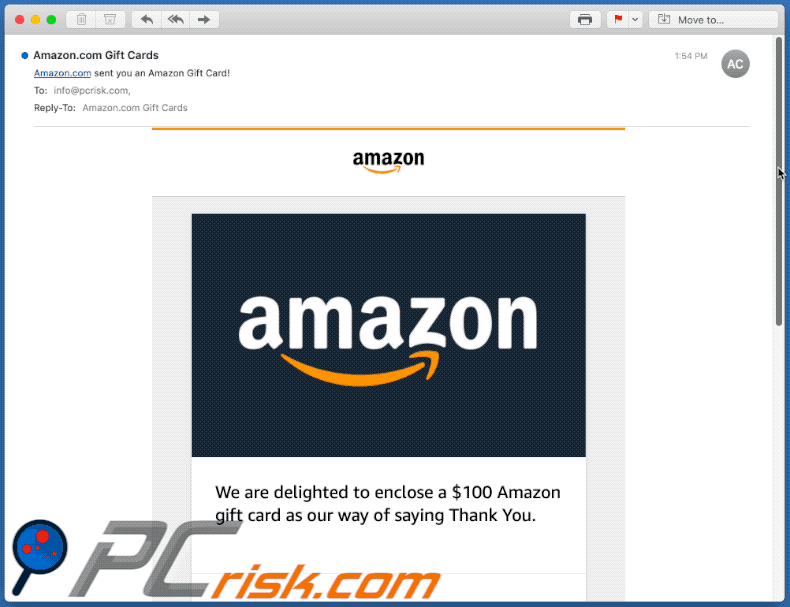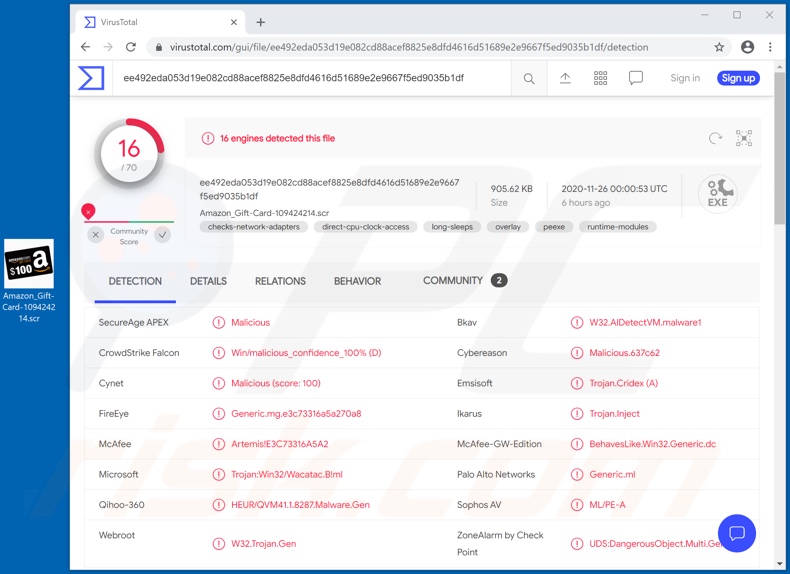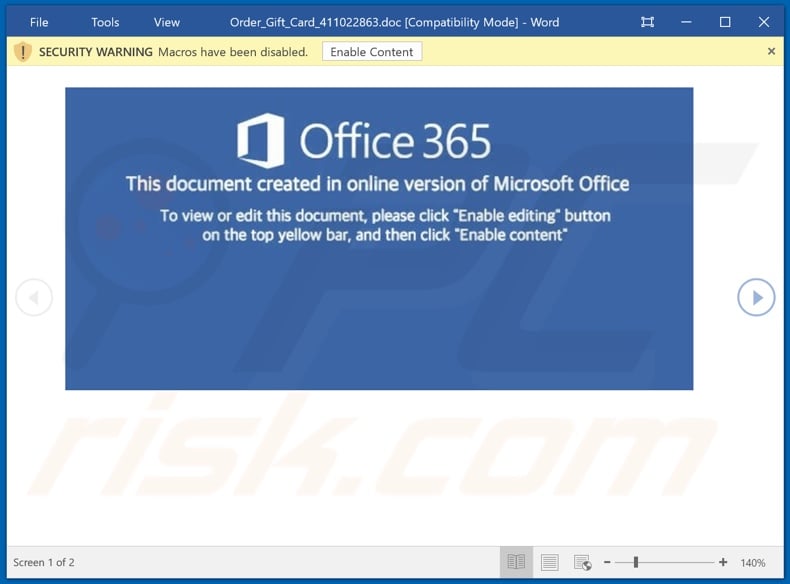Do not trust fake Amazon emails offering US$100 (USD) gift cards
Phishing/ScamAlso Known As: $100 Amazon Gift Card spam
Get free scan and check if your device is infected.
Remove it nowTo use full-featured product, you have to purchase a license for Combo Cleaner. Seven days free trial available. Combo Cleaner is owned and operated by RCS LT, the parent company of PCRisk.com.
What is "$100 Amazon Gift Card email virus"?
"$100 Amazon Gift Card email virus" refers to an email spam campaign designed to proliferate Dridex malware. The term "spam campaign" is used to define a large-scale operation, during which thousands of scam emails are sent.
The messages distributed through this spam campaign claim that recipients have received an Amazon gift card, however, these deceptive emails are in no way associated with Amazon.com, Inc. The link presented in the "$100 Amazon Gift Card" scam messages downloads a malicious file. If opened, this file initiates the infection chain of Dridex.
At the time of research, it downloaded an infectious SRC file or Microsoft Office document. Dridex malware's primary functionality is extraction and exfiltration of information relating to finances/banking.

The "$100 Amazon Gift Card" scam emails (the subject "Amazon.com sent you an Amazon Gift Card!" might vary) may seem relatively legitimate and contain several graphical elements (i.e. logos) used by Amazon.com, Inc. The messages inform recipients that they have received an Amazon gift card worth US$100 as a sign of gratitude.
The deceptive emails then go into detail about what recipients must do if they do not have an Amazon account. They are instructed to create a new account to redeem the gift card. Once this is done, the full amount is supposedly added to their gift card balance.
This sum cannot be transferred between Amazon accounts, used to purchase other gift cards, or redeemed for cash. Using the card will require only one click during the checkout process. It is also possible to opt-out from paying an order with the gift card by deselecting it as a payment method during checkout.
These fake Amazon emails ask recipients to share this information on their social networking/media accounts (e.g. Facebook, Twitter, Instagram and Pinterest). This is used as another method to spread the email and by extension, Dridex malware.
As mentioned, the "View details" button (i.e. link) redirects to a malicious website, from which either a dangerous SRC file or Microsoft Office document is downloaded. When opened, these files begin the infection chain (i.e. download/installation process) of Dridex malware.
The malicious program is mainly geared towards stealing banking credentials (i.e. IDs, usernames and passwords). This software mainly uses keylogging for this purpose - this is recording of key strokes, thereby allowing cyber criminals access typed information.
To summarize, by trusting the "$100 Amazon Gift Card" scam emails, users might experience system infections, serious privacy issues, financial loss and identity theft. If it is suspected/known that Dridex (or other malware) has already infected the device, use an anti-virus software to eliminate it immediately.
| Name | 0 Amazon Gift Card spam |
| Threat Type | Trojan, password-stealing virus, banking malware, spyware. |
| Hoax | Scam emails claim recipients have received a US$100 (USD) Amazon gift card. |
| Attachment(s) | Amazon_Gift-Card-109424214.scr and Order_Gift_Card_411022863.doc (filenames might vary). |
| Detection Names (Amazon_Gift-Card-109424214.scr) | DrWeb (Trojan.Dridex.735), Emsisoft (Trojan.Cridex (A)), McAfee (Artemis!E3C73316A5A2), Kaspersky (UDS:DangerousObject.Multi.Generic), Full List Of Detections (VirusTotal). |
| Detection Names (Order_Gift_Card_411022863.doc) | McAfee (X97M/Downloader.gh), BitDefender (VBA:Amphitryon.1300), Fortinet (VBA/Agent.UFY!tr.dldr), Kaspersky (HEUR:Trojan.MSOffice.Alien.gen), Full List Of Detections (VirusTotal). |
| Symptoms | Trojans are designed to stealthily infiltrate the victim's computer and remain silent, and thus no particular symptoms are clearly visible on an infected machine. |
| Payload | Dridex |
| Distribution methods | Infected email attachments, malicious online advertisements, social engineering, software 'cracks'. |
| Damage | Stolen passwords and banking information, identity theft, the victim's computer added to a botnet. |
| Malware Removal (Windows) |
To eliminate possible malware infections, scan your computer with legitimate antivirus software. Our security researchers recommend using Combo Cleaner. Download Combo CleanerTo use full-featured product, you have to purchase a license for Combo Cleaner. 7 days free trial available. Combo Cleaner is owned and operated by RCS LT, the parent company of PCRisk.com. |
"CDP Email Virus", "Ministro Dell'Economia E Delle Finanze", "FedEx Invoice Ready", and "Teco New Order" are some examples of other malware-spreading spam campaigns. These deceptive emails can have a wide variety of disguises.
The messages can offer various prizes, gifts, discounts, deals, etc., notify people of "important" information/developments, make requests of recipients, threaten and/or make demands, and so on. In fact, spam mail is not used exclusively to proliferate malicious programs - it is also used for phishing and other scams.
Regardless of how these messages operate or what they promise/threaten, their purpose is solely to generate revenue for the scammers/cyber criminals behind them. Due to the relative prevalence of these emails, you are strongly advised to exercise caution with incoming messages.
How did "$100 Amazon Gift Card email virus" infect my computer?
Typically, cyber criminals behind malspam campaigns send emails with a file attached to them or a download link to the malicious file. Their main goal is to trick recipients into opening/executing the rogue file, which then installs malicious software.
Some examples of files that cyber criminals send via email are Microsoft Office and PDF documents, executables (.exe), JavaScript, and archives (ZIP, RAR). Note that malicious documents that are opened with Microsoft Office 2010 or newer versions install malicious software only if users enable macros commands (enable editing/content).
These versions include "Protected View" mode, which does not allow opened malicious documents to install malware automatically. Older versions do not include this feature and install malicious software without asking permission.
How to avoid installation of malware
To avoid infecting the system with malware spread through spam mail, you are strongly advised not to open suspicious or irrelevant emails, especially those with any attachments or links present in them.
Use official and verified download channels. Additionally, all programs must be activated and updated with tools/functions provided by legitimate developers, since illegal activation tools ("cracks") and third party updaters commonly proliferate malicious software.
To ensure device integrity and user safety, it is paramount to have reputable anti-virus/anti-spyware installed and kept updated. Furthermore, use these programs to run regular system scans and to remove detected/potential threats.
If you have already opened a "$100 Amazon Gift Card email virus" attachment, we recommend running a scan with Combo Cleaner Antivirus for Windows to automatically eliminate infiltrated malware.
Text presented in the "$100 Amazon Gift Card" scam email message:
Subject: Amazon.com sent you an Amazon Gift Card!
We are delighted to enclose a $100 Amazon gift card as our way of saying Thank You.
Ordered on November 25, 2020
Order #808-9862519-7825262
$100.00
Amazon Gift Card
View details
Don't have an Amazon account?
Sign up to redeem.
Once applied to your Amazon account, the entire amount will be added to your gift card balance. Your gift card balance can't be transferred to other accounts, used to buy other gift cards, or, except as required by law, redeemed for cash.
Your gift card balance will be applied automatically to eligible orders during the checkout process and when using 1-Click. If you don't want to use your gift card balance on your order, you can unselect it as a payment method in checkout.
Amazon.com Logo
Share via FacebookTweet itPost to InstagramPin it on Pintrest
This email message was sent from a notification only address that cannot accept incoming email. Please do not reply to this message.
Sold by ACI Gift Cards LLC., an Amazon company. View Terms and Conditions.
Screenshot of VirusTotal detections of the malicious file ("Amazon_Gift-Card-109424214.scr") distributed via "$100 Amazon Gift Card" spam campaign:

Screenshot of the alternative malicious file ("Order_Gift_Card_411022863.doc") distributed via "$100 Amazon Gift Card" spam campaign:

Instant automatic malware removal:
Manual threat removal might be a lengthy and complicated process that requires advanced IT skills. Combo Cleaner is a professional automatic malware removal tool that is recommended to get rid of malware. Download it by clicking the button below:
DOWNLOAD Combo CleanerBy downloading any software listed on this website you agree to our Privacy Policy and Terms of Use. To use full-featured product, you have to purchase a license for Combo Cleaner. 7 days free trial available. Combo Cleaner is owned and operated by RCS LT, the parent company of PCRisk.com.
Quick menu:
- What is 0 Amazon Gift Card spam?
- Types of malicious emails.
- How to spot a malicious email?
- What to do if you fell for an email scam?
Types of malicious emails:
![]() Phishing Emails
Phishing Emails
Most commonly, cybercriminals use deceptive emails to trick Internet users into giving away their sensitive private information, for example, login information for various online services, email accounts, or online banking information.
Such attacks are called phishing. In a phishing attack, cybercriminals usually send an email message with some popular service logo (for example, Microsoft, DHL, Amazon, Netflix), create urgency (wrong shipping address, expired password, etc.), and place a link which they hope their potential victims will click on.
After clicking the link presented in such email message, victims are redirected to a fake website that looks identical or extremely similar to the original one. Victims are then asked to enter their password, credit card details, or some other information that gets stolen by cybercriminals.
![]() Emails with Malicious Attachments
Emails with Malicious Attachments
Another popular attack vector is email spam with malicious attachments that infect users' computers with malware. Malicious attachments usually carry trojans that are capable of stealing passwords, banking information, and other sensitive information.
In such attacks, cybercriminals' main goal is to trick their potential victims into opening an infected email attachment. To achieve this goal, email messages usually talk about recently received invoices, faxes, or voice messages.
If a potential victim falls for the lure and opens the attachment, their computers get infected, and cybercriminals can collect a lot of sensitive information.
While it's a more complicated method to steal personal information (spam filters and antivirus programs usually detect such attempts), if successful, cybercriminals can get a much wider array of data and can collect information for a long period of time.
![]() Sextortion Emails
Sextortion Emails
This is a type of phishing. In this case, users receive an email claiming that a cybercriminal could access the webcam of the potential victim and has a video recording of one's masturbation.
To get rid of the video, victims are asked to pay a ransom (usually using Bitcoin or another cryptocurrency). Nevertheless, all of these claims are false - users who receive such emails should ignore and delete them.
How to spot a malicious email?
While cyber criminals try to make their lure emails look trustworthy, here are some things that you should look for when trying to spot a phishing email:
- Check the sender's ("from") email address: Hover your mouse over the "from" address and check if it's legitimate. For example, if you received an email from Microsoft, be sure to check if the email address is @microsoft.com and not something suspicious like @m1crosoft.com, @microsfot.com, @account-security-noreply.com, etc.
- Check for generic greetings: If the greeting in the email is "Dear user", "Dear @youremail.com", "Dear valued customer", this should raise suspiciousness. Most commonly, companies call you by your name. Lack of this information could signal a phishing attempt.
- Check the links in the email: Hover your mouse over the link presented in the email, if the link that appears seems suspicious, don't click it. For example, if you received an email from Microsoft and the link in the email shows that it will go to firebasestorage.googleapis.com/v0... you shouldn't trust it. It's best not to click any links in the emails but to visit the company website that sent you the email in the first place.
- Don't blindly trust email attachments: Most commonly, legitimate companies will ask you to log in to their website and to view any documents there; if you received an email with an attachment, it's a good idea to scan it with an antivirus application. Infected email attachments are a common attack vector used by cybercriminals.
To minimise the risk of opening phishing and malicious emails we recommend using Combo Cleaner Antivirus for Windows.
Example of a spam email:

What to do if you fell for an email scam?
- If you clicked on a link in a phishing email and entered your password - be sure to change your password as soon as possible. Usually, cybercriminals collect stolen credentials and then sell them to other groups that use them for malicious purposes. If you change your password in a timely manner, there's a chance that criminals won't have enough time to do any damage.
- If you entered your credit card information - contact your bank as soon as possible and explain the situation. There's a good chance that you will need to cancel your compromised credit card and get a new one.
- If you see any signs of identity theft - you should immediately contact the Federal Trade Commission. This institution will collect information about your situation and create a personal recovery plan.
- If you opened a malicious attachment - your computer is probably infected, you should scan it with a reputable antivirus application. For this purpose, we recommend using Combo Cleaner Antivirus for Windows.
- Help other Internet users - report phishing emails to Anti-Phishing Working Group, FBI’s Internet Crime Complaint Center, National Fraud Information Center and U.S. Department of Justice.
Share:

Tomas Meskauskas
Expert security researcher, professional malware analyst
I am passionate about computer security and technology. I have an experience of over 10 years working in various companies related to computer technical issue solving and Internet security. I have been working as an author and editor for pcrisk.com since 2010. Follow me on Twitter and LinkedIn to stay informed about the latest online security threats.
PCrisk security portal is brought by a company RCS LT.
Joined forces of security researchers help educate computer users about the latest online security threats. More information about the company RCS LT.
Our malware removal guides are free. However, if you want to support us you can send us a donation.
DonatePCrisk security portal is brought by a company RCS LT.
Joined forces of security researchers help educate computer users about the latest online security threats. More information about the company RCS LT.
Our malware removal guides are free. However, if you want to support us you can send us a donation.
Donate
▼ Show Discussion